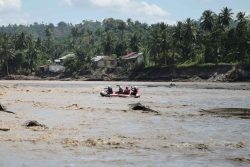‘Sea-sun-sand-self’ Tourists Threaten Ancient, Sacred Rainforest in Mountainous Bali Area
16:20 JST, October 30, 2023
BULELENG, Indonesia (Thomson Reuters Foundation) — Deep inside his tribe’s sacred rainforest on the Indonesian holiday island of Bali, Indigenous guide Putu Willy Suputra looks on in disbelief as a group of tourists video themselves mimicking monkeys by swinging on a long, woody vine.
Suputra is a member of the 20,000-strong Adat Dalem Tamblingan Indigenous community who have lived in northern Bali since the ninth century and want rights to curb tourism and protect their rainforest and lake.
“These types of things really hurt me,” the 27-year-old said. “That liana will definitely die.”
“If we go into this forest, it is enough to walk, see, hear and leave a footprint, but we don’t need to do anything extra — like picking something or swinging from a tree,” he added.
“Most people are [only] thinking about the four Ss — sea, sun, sand and self. They don’t care about the culture of the [Balinese] people.”
From Venice to Bhutan, prized vacation destinations are seeking to limit tourism to protect locals and cultural sites, but without scaring off too many job-creating visitors with exorbitant taxes, hiking fees and other charges.
Bali, one of thousands of islands in Indonesia, is welcoming back visitors after COVID-19 restrictions, but critics fear the culture, traditions and rights of the predominantly Hindu island are under threat from mass tourism.
Bali has targeted 4.5 million international visitors for 2023 — more than its estimated 4.4 million residents — in a rebound from almost none during pandemic lockdowns. Before COVID, Bali had about 6.2 million visitors in 2019.
Tourism is putting huge pressure on the island’s limited infrastructure and has led to problems including soaring land prices, large developments, traffic jams clogging narrow streets and trash on once-pristine beaches.
The Alas Mertajati Forest and Lake Tamblingan are a near three-hour drive from the spas, yoga retreats, beach resorts and Bintang beer T-shirts of southern Bali, which has been Indonesia’s main tourist magnet for decades and made popular by the bestselling memoir “Eat, Pray, Love.”
The handful of tourists who make it to the mountainous Buleleng regency usually sleep at homestays and go trekking or cycling, visit the ancient temples or simply take in the slow pace of rural life among coffee and clove plantations.
‘Supporting actors’
Indonesia has in the last two years considered huge hikes in ticket prices to some of its most popular tourism sites, such as the Komodo national park which is home to the famous dragons — the world’s largest lizards — and the Borobudur Buddhist temple.
The plans spurred protests by tourism workers who feared for their jobs and were eventually scaled back.
Putu Ardana, a village elder in the Adat Dalem Tamblingan community, said Indigenous peoples should be able to decide what type of tourists can visit sacred areas. He said the emphasis should be on research, education and culture.
“Tourism is just a bonus. If we conserve our tradition, culture or farms [and] we do what we do best — people who like seeing our culture will come,” the 67-year-old said.
“What makes me sad is the actors of tourism in [southern Bali] are not actually Balinese, they’re people from Jakarta, investors from abroad. We Balinese are just supporting actors,” he added, with tears in his eyes.
The community wants government recognition of their “customary rights” to manage the forest and lake as ancestral lands dating back centuries.
“It is a race against time — the faster we can get recognition for the customary forest and lake, the sooner we can implement all the things needed to conserve it,” Ardana said.
In 2016, Indonesia announced that it would return customary lands to Indigenous peoples. To date, the country has recognized about 153,000 hectares for 108 communities, the government says.
President Joko Widodo vowed to return 12.7 million hectares of such land to Indigenous people, but progress has been slow. Land rights activists said the recognition process is cumbersome and prone to political interference.
A spokesman for Indonesia’s ministry of environment and forestry declined to comment.
Sumarsono, the head of the Bali natural resources conservation agency, said the Adat Dalem Tamblingan could apply to the central government for customary rights for the forest and lake. To date, this has not happened, he said.
Before this, however, the Adat Dalem Tamblingan need official recognition as an Indigenous group from both the local and central governments. An application was filed in 2019 but little progress has been made despite repeated requests, community members said.
The forest and lake have previously been designated as conservation areas, under which tourism must give priority to nature, for instance by banning permanent buildings and by limiting visits, Sumarsono said.
“In principle, it is not for mass tourism,” he added.
Global pledges
A landmark global deal to protect nature agreed in Montreal late last year enshrined respect for the rights of Indigenous peoples as a key element for conservation.
Tourism can lead to the destruction of natural habitats, particularly forests and often land where Indigenous groups reside, said Danny Marks, assistant professor of environmental politics and policy at Dublin City University.
Developers often clear forests and mangroves and drain wetlands to make way for hotels, resorts and malls in Bali — and golf courses and train lines in nations such as Vietnam and Mexico, he added.
Governments have also displaced Indigenous communities to designate land as national parks or protected areas. Indigenous peoples are sometimes then branded as illegal settlers who can be arrested, Marks said.
“If tourism wants to ensure nobody is left behind, tourist operators and companies need to work directly with Indigenous communities, businesses, and NGOs — and governments should grant formal rights to their ancestral lands,” he said.
Rakhmat Hidayat, a regional manager at non-profit think-tank WRI Indonesia, recommended “eco-educational tourism” for Indigenous peoples.
Such tourism can teach visitors about local culture, forest plants and ecosystems, offer tree adoption, and help develop forest-related products like honey or crafts.
“The community benefits economically while still being able to live in harmony with their traditional culture,” Hidayat said.
Tales of dragons
Shrouded in mountain mist, Lake Tamblingan, which supplies fresh water to villages and resorts across Bali, is believed by the Adat Dalem Tamblingan people to have medicinal and life-giving properties.
Village elders often swap stories of dragons appearing from the crystal-clear waters, or giant fish the size of boats that once caused a shocked, local fisherman to faint.
The surrounding 1,339-hectare Alas Mertajati Forest was mapped by local youths as part of community attempts to reconnect young people with their rainforest and gain customary rights.
"World" POPULAR ARTICLE
-

8 Japanese Nationals Stranded on Indonesia’s Sumatra Island
-

U.S. Senate Resolution Backs Japan, Condemns China’s Pressure
-

China to Impose Sanctions on Shigeru Iwasaki, Former Head of Japan’s Self-Defense Forces, Who Serves as Adviser to Taiwan’s Executive Branch
-

South Korea’s Top Court Dismisses Nippon Steel Appeal in Lawsuit over Requisitioned Worker
-

75% of Myanmar People Reject Army’s Political Involvement, According to Survey Conducted by Aid Organization
JN ACCESS RANKING
-

Tokyo Economic Security Forum to Hold Inaugural Meeting Amid Tense Global Environment
-

Keidanren Chairman Yoshinobu Tsutsui Visits Kashiwazaki-Kariwa Nuclear Power Plant; Inspects New Emergency Safety System
-

Imports of Rare Earths from China Facing Delays, May Be Caused by Deterioration of Japan-China Relations
-

University of Tokyo Professor Discusses Japanese Economic Security in Interview Ahead of Forum
-

Japan Pulls out of Vietnam Nuclear Project, Complicating Hanoi’s Power Plans





















